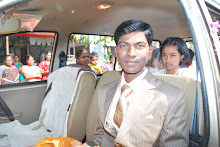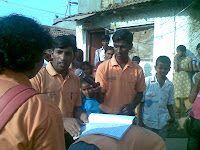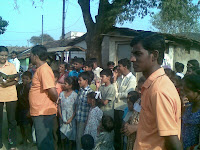VIllage study--------Hosawal 24 to 26 feb 2009
I did the Hoswal village study.The villagers are facing no water supply problem,this is due to the Transformer burning.Since one month the villagers are not getting drinking water.The reason for the Transformer burning is the framers those who are using borewell around that Transformer.
Details of the Transformer
25 kw transformer can be used for three bore wells.
Farmers are using four bore wells and one mini water pump.
One bore well will take 4 – 5 kw (approx) depend on capacity of submersible pump.
63 kw transformer can used for 10 bore wells.
Each farmers has to pay 2000 Rs for transformer.
Pocket money to line man.
Pocket money to line man means,whenever the line man comes to check the Transformer the villafers has to give pocket to line man otherwise he will not repair .
Why delay in replacing transformer
I. Negligence of
1.Villagers
2.Gram panchayat
II. Carelessness of
1.KEB Line man
ØFour bore well within 1 km from transformer.
ØThree transformer are burnt in last 3 years.
ØFour people are responsible for transformer burning.
Name of farmer Capacity of Transformer Type
Yallappa Lakkapanavar 5 hp Submersible
Madivallappa Lakkapanavar 3hp “
Kariyappa 7hp “
Lingangouda patil 7hp “
Date of replacing the transformers
05/06
07/08
02/09
Cost of 25 kw transformer is 65000 to 70000 Rs (approx)
Cost of 63 kw transformer is 120000 Rs (approx)
KEB has spent 1,95,000 on transformers
Farmers contributed amount is 9000 Rs.
Total amount KEB spent is 1,86,000 Rs
Main reason for transformer burning
Farmers are Converting single phase into three phase
Now KEB people replaced 25 kw transformer into 63 kw transformer
For more details log on to our web site
www.deshpandefoundation.org
How To Splice Into Existing Electrical Wire
-
[image: How to splice into existing electrical wire]
How to splice into existing electrical wire
Using electrician's pliers, twist together the stripped en...
4 days ago



 e, Aushutosh and Tippanna teaching was excellent.
e, Aushutosh and Tippanna teaching was excellent.